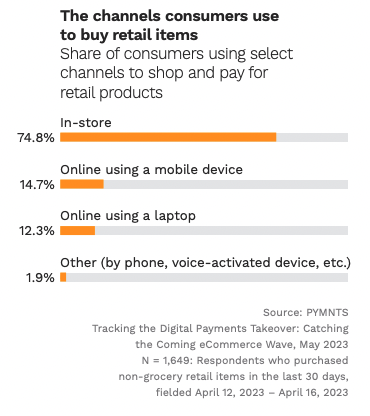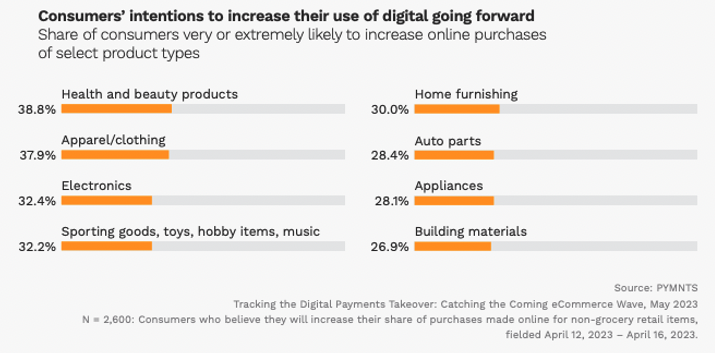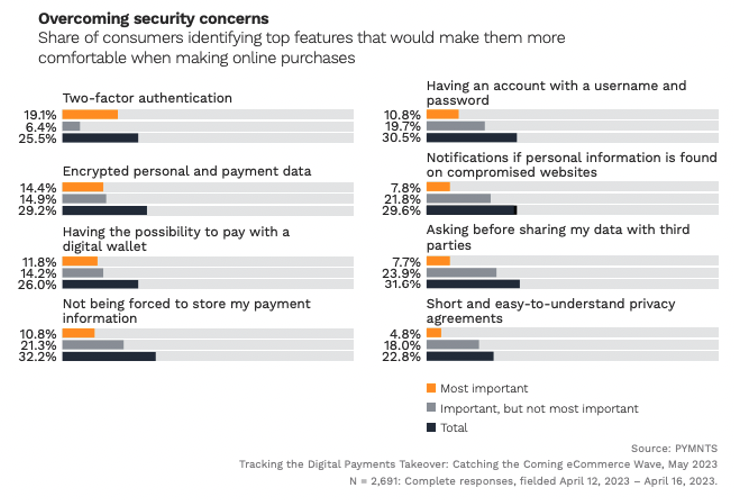After a stellar run through the pandemic, eCommerce was humbled as consumers flocked back to physical stores in 2022 and 2023.
The wheel is turning again, as new data shows the appetite for eCommerce is back on a strong growth trajectory, and retailers need to be ready for it.
With mobile and digital shopping and payments poised to play an outsized role in a reinvigorated eCommerce ecosystem, issues from payment choice to data security are on the minds of shoppers, and these are critical areas requiring new approaches and system upgrades.

In the study “Tracking the Digital Payments Takeover: Catching the Coming eCommerce Wave,” a PYMNTS and Amazon Web Services (AWS) collaboration, a survey of nearly 3,000 U.S. consumers noted that the share of retail spending that occurs in-store could drop as nearly one-third of consumers expect to lean more on digital channels in the second half of the year.
A prime use case is grocery shopping, an activity that continued to happen predominantly in stores even during COVID-19 lockdowns. But it’s kept edging higher, and 32% of consumers said they are highly likely to increase their online grocery purchases in the next year.
That’s a bonus for retailers in a few ways, starting with the typically larger basket sizes observed among online grocery shoppers versus in-store excursions.
Advertisement: Scroll to Continue
“Consumers who shop and pay online spend an average of $28 more per grocery order made online than they spend on grocery orders placed in-store,” the study found. “It is not clear whether these online grocery shoppers are paying more due to buying higher-priced items because they are buying more items, or because they include the cost of aggregator delivery fees in their estimations, however, this will represent a key area for investigation going forward.”
In non-grocery online spend, the outlook is equally promising. Here, 30% of consumers surveyed said they see themselves buying more online in the coming 12 months and beyond, with mobile playing a pivotal role in that commerce.

In retail goods like electronics and apparel, as with groceries, customers spend more when shopping online. Consumers who buy retail items online spend an average of $42 more per purchase than consumers who buy their retail items in-store, representing a 48% increase.
“Mobile commerce is especially important for the retail sector, with 15% of purchases in April 2023 being completed via mobile and 12% being completed via desktop/laptop,” the study found. “Merchants could therefore have an opportunity to gain a competitive edge by providing both desktop- and mobile-optimized shopping and payment options.”

Catering to Payments Preference
As digital-first payment methods go, PayPal and Apple Pay are in the lead in the U.S. at present, with 12% of all online non-grocery retail purchases made using PayPal in April, and 3% made with Apple Pay. However, Apple Pay is used slightly more often in stores, netting 2% of the in-store retail purchases in April, versus less than 1% done with PayPal.
Online payments are a more complex mix, and retailers must be careful not to fall behind the payment technology use that is being driven by consumer preference and choice.
“Consumers expect to increase their use of nearly every type of digital-native payment method in the next year, but PayPal use is expected to grow the most in that time,” with 23% of consumers reporting they will increase their use of PayPal for online purchases in the next year, the study found. For Apple Pay, the online increase equates to a 10% increase.
Credit and debit cards will continue to dominate in the near term, but the data showed their lead being eroded more quickly now by digital payments, with PayPal and Apple Pay closing in most.

Securing the eCommerce Wave
Underlying the post-pandemic resurgence of eCommerce are data security concerns that make many shoppers less confident in online shopping with any non-cash form of payment.
While many retailers have invested heavily in payments security, to profit best from rising eCommerce use, they need to beef up security even more, including the use of two-factor authentication (2FA), advanced encryption and adding acceptance of digital wallets that bring more security to the game.
“Merchants seeking to assuage these concerns will also need to address some of the most common pain points consumers experience when shopping online: high shipping costs, delivery delays and fears of overspending,” the study stated. “Twenty-seven percent of consumers cited delivery delays and 24% cited high shipping costs as issues they experienced with online purchases.”

